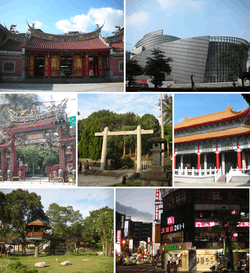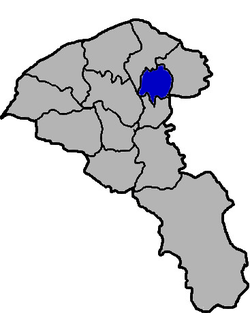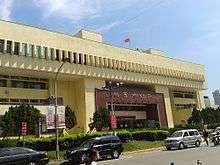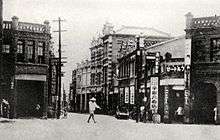Taoyuan District
Taoyuan District (Chinese: 桃園區; pinyin: Táoyuán Qū), formerly known as Taoyuan City (桃園市), is a district of Taoyuan City in northwestern Taiwan. The seat of Taoyuan City is situated within its borders. It is the most populous district among the 12 districts of Taoyuan City, and the second most populous among the many districts of Taiwan, with the most populous being Banqiao District in New Taipei City.
Taoyuan 桃園區 | |
|---|---|
| Taoyuan District | |
 Clockwise from center: Taoyuan Martyrs' Shrine, Hutoushan Park, Taoyuan Jinfu Temple, Taoyuan Wenchang Temple, Taoyuan Exhibition Center, Taoyuan Confucius Temple, Zhongzhen Road | |
 | |
| Coordinates: 25°00′N 121°18′E | |
| Country | Republic of China (Taiwan) |
| Municipality | Taoyuan City |
| Area | |
| • Total | 34.8 km2 (13.4 sq mi) |
| Population (January 2016) | |
| • Total | 427,815 |
| • Density | 12,000/km2 (32,000/sq mi) |
| Website | www.taocity.gov.tw |

History

Taoyuan is the native home to the plains tribes of Taiwanese aborigines. Taoyuan's old name was Toahong[1] (Chinese: 桃仔園; pinyin: Táozǐyuán; Pe̍h-ōe-jī: Thô-á-hn̂g; lit.: 'peach orchard') since there used to be many peach blossoms in the area.
Japanese rule

Under Japanese rule, the area was part of Toshien Chō (桃仔園廳) established in November 1901. In 1920, it was renamed Tōen Town (桃園街), and incorporated into Tōen District, Shinchiku Prefecture.
Post-war
After the handover of Taiwan from Japan to the Republic of China, it was reorganized as Taoyuan Town of Taoyuan County. On 21 April 1971, the town was upgraded from an urban township to a county-controlled city called Taoyuan City.[2] On 25 December 2014, the city became a district of the newly formed special municipality of Taoyuan City.
Geography
Taoyuan is located on the Taoyuan Plateau, contiguous on the northeast to Guishan District. The Nankan River is Taoyuan's largest river, flowing from the southeast to the northwest.
- Area: 34.80 km2 (13.44 sq mi)
- Elevation: 157 ft (48 m)
- Population: 427,815 people (January 2016)
Climate
Taoyuan has a humid subtropical climate (Köppen climate classification: Cfa), with hot summers and mild winters. Precipitation is high throughout the year and is generally higher in the first half of the year. Due to the effect of wind from mainland China, Taoyuan is typically cooler than New Taipei, despite having a lower latitude.
Administrative divisions
Dalin, Dafeng, Jianguo, Yunlin, Fuan, Fulin, Fenglin, Zhonghe, Zhongxing, Wenhua, Wenchang, Wenming, Beimen, Minsheng, Yongxing, Guangxing, Ximen, Xihu, Wuling, Zhangmei, Nanmen, Nanhua, Zhongshan, Zhongping, Zhongzheng, Zhongcheng, Zhongxin, Zhongyuan, Zhongtai, Zhongsheng, Zhonglu, Zhongde, Wenzhong, Yushan, Taishan, Longshan, Longan, Longgang, Longxiang, Longshou, Longfeng, Zhongpu, Zhongning, Beipu, Yongan, Tongan, Tongde, Zijiang, Xipu, Mingde, Tungpu, Zhangan, Zhangde, Xinguang, Nanpu, Zhuangjing, Ciwen, Xinpu, Ruiqing, Bao'an, Baoqing, Sanyuan, Sanmin, Dayou, Daxing, Chenggong, Bianzhou, Zhongyi, Tungshan, Tungmen, Jingxi, Chunri, Zhaoyang, Guiji, Wanshou and Baoshan Village.
Government institutions
Education
Within Taoyuan, there are 6 senior high schools, 14 junior high schools, 23 primary schools, and an "intelligence initiation school." Taoyuan is also home to a number of buxibans, or cram schools or language schools, which teach additional courses in mathematics, English, science, etc. There are also 10 universities located in Taoyuan.
Economy
Taoyuan was one of the host cities for the Taiwan European Film Festival in 2012.[3]
Transportation
Railway
Taoyuan Station
Bus
Metro
International relations
Twin towns – Sister cities
Taoyuan is twinned with:



Tourist attractions
Notable natives
- Wu Ming-yi, artist and author
References
- Davidson, James W. (1903). The Island of Formosa, Past and Present : history, people, resources, and commercial prospects : tea, camphor, sugar, gold, coal, sulphur, economical plants, and other productions. London and New York: Macmillan. p. 597. OCLC 1887893. OL 6931635M.CS1 maint: ref=harv (link)
- http://www.taocity.gov.tw/en/about.aspx
- Bartholomew, Ian (November 11, 2012). "European film festival opens". Taipei Times.
- "Radom - Miasta partnerskie" [Radom - Partnership cities]. Miasto Radom [City of Radom] (in Polish). Archived from the original on April 3, 2013. Retrieved August 7, 2013.
- "Sister Cities Program". City of Irvine. June 6, 2015. Retrieved September 17, 2018.
- Ginsburg, Norton Sydney; et al. (1991). The Extended metropolis: settlement transition in Asia. University of Hawaii Press. ISBN 9780824812973. Retrieved February 6, 2012.
External links
| Wikimedia Commons has media related to Taoyuan District, Taoyuan. |
- Taoyuan City Office (in English)